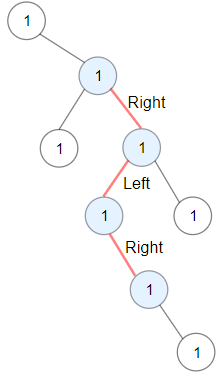You are given the root of a binary tree.
A ZigZag path for a binary tree is defined as follow:
- Choose any node in the binary tree and a direction (right or left).
- If the current direction is right, move to the right child of the current node; otherwise, move to the left child.
- Change the direction from right to left or from left to right.
- Repeat the second and third steps until you can’t move in the tree.
Zigzag length is defined as the number of nodes visited - 1. (A single node has a length of 0).
Return the longest ZigZag path contained in that tree.
Example

Input: root = [1,null,1,1,1,null,null,1,1,null,1,null,null,null,1,null,1]
Output: 3
Explanation: Longest ZigZag path in blue nodes (right -> left -> right).
Solution
/**
* Definition for a binary tree node.
* function TreeNode(val, left, right) {
* this.val = (val===undefined ? 0 : val)
* this.left = (left===undefined ? null : left)
* this.right = (right===undefined ? null : right)
* }
*/
/**
* @param {TreeNode} root
* @return {number}
*/
let ans = 0;
//dfs to find the longest zigzag path
var dfs = (root, left, steps) => {
if (root == undefined) {
return;
}
//update the longest zigzag path
ans = Math.max(ans, steps);
//if left is true, we are going left to right
if (left) {
dfs(root.left, !left, steps + 1);
dfs(root.right, left, 1);
}
//if left is false, we are going right to left
else {
dfs(root.left, left, 1);
dfs(root.right, !left, steps + 1);
}
};
var longestZigZag = function (root) {
ans = 0;
//start from left and right
dfs(root, true, 0);
//start from right and left
dfs(root, false, 0);
return ans;
};